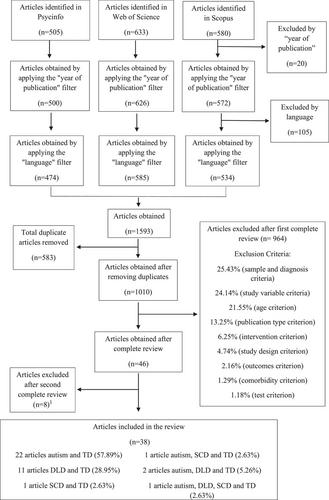How language affects social cognition and emotional competence in typical and atypical development: A systematic review
Abstract
Background
The ability to understand the mental state of others (social cognition), as well as language, is crucial for children to have good social adaptation. Social cognition (SC) has been shown to be a hierarchical model of three factors (Cognitive, intermediate and affective SC) interrelated with linguistic processes. Children on the autism spectrum and children with developmental language disorder (DLD) or social communication disorder (SCD) manifest language and SC difficulties, albeit in different ways.
Aims
This systematic review aims to find how language and SC interact with each other and identify linguistic and socio-affective profiles in the target population.
Methods
About 1593 articles were systematically reviewed according to the Preferred Reporting Items for Systematic Reviews and Meta-Analyses guide in November 2022, obtaining, through inclusion/exclusion criteria, a total of 38 articles for qualitative assessment. The majority of them were on autism (26) or DLD (14) and to a lesser extent SCD (3).
Main Contribution
Although SC is related to all components of language, SC is strongly related to narrative and morphosyntax and partially related to lexicon. Pragmatics shows a complex relation with SC due to greater sensitivity to other factors such as age or task, and prosody appears to be more related to emotional processes. Besides, autistic, SCD and DLD children showed differences in their language and socio-affective performance. Mainstream DLD children have lower performance in general language, where autistic and SCD children have more linguistic variation and are lower in pragmatic and SC tasks, SCD children being more associated with language production difficulties and autistic children with both receptive and productive language.
Conclusion
Each language component has a different interaction with SC. Likewise, different linguistic profiles are partially found for each disorder. These results are important for future lines of research focusing on specific components of interaction and socio-emotional processes, as well as for clinical and educational treatment.
What this paper adds
What is already known on the subject
- The hierarchical model of Schurz et al. (2021), divide social cognition into three brain constructs: cognitive social cognition (CSC), affective social cognition (ASC) and intermediate social cognition (ISC). They observe a large relationship between language and ISC, a fact that has been corroborated with some other studies. Studies have also found lower linguistic and socio-affective abilities in children with autism and language and communication disorders compared with children with neurotypical development, and large behavioural and neurocognitive overlaps between these disorders (Durrleman et al., 2019; Löytömäki et al., 2019).
What this paper adds to existing knowledge
- This is the first review that relates all linguistic components (narrative, lexicon, morphosyntax, pragmatic and prosody) with the three constructs of social cognition (Cognitive, intermediate and affective). Moreover, it is the first review that studies the socio-linguistic factors comparing autism, developmental language disorder and social communication disorder with each other and with neurotypical development in children aged from 4 to 9 years.
What are the potential or actual clinical implications of this work?
- Understanding how language and social cognition interact with each other in autism spectrum disorder, developmental language disorder and social communication disorder allows us to trace socio-linguistic profiles for each of the studied disorders, understand better children with these difficulties, and, with this, find specific potential intervention points to improve and prevent these difficulties.


 求助内容:
求助内容: 应助结果提醒方式:
应助结果提醒方式:


